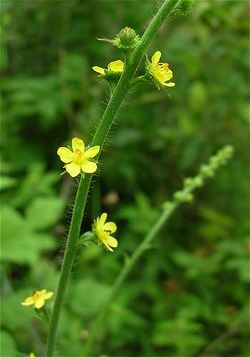Difference between revisions of "Agrimonia gryposepala"
From Wikiwel
(Created page with "Agrimonia gryposepala Other Names : tall hairy agrimony, common agrimony, hooked agrimony, tall hairy...") |
|||
| Line 8: | Line 8: | ||
* The Ojibwe used the plant for urinary problems, | * The Ojibwe used the plant for urinary problems, | ||
* The Meskwaki and Prairie Potawatomi used it as a styptic for nosebleeds. | * The Meskwaki and Prairie Potawatomi used it as a styptic for nosebleeds. | ||
| − | |||
These ethnobotanical uses of the plant have some similarities to the traditional medical uses of [[Agrimonia eupatoria]], which is native to Europe, Asia, and Africa. | These ethnobotanical uses of the plant have some similarities to the traditional medical uses of [[Agrimonia eupatoria]], which is native to Europe, Asia, and Africa. | ||
| + | ==References== | ||
| + | ''* "Plants Profile for Agrimonia gryposepala (tall hairy agrimony )". plants.usda.gov. Retrieved 22 January 2018.'' | ||
| + | ''* James W. Herrick and Dean R. Snow (1997). Iroquois Medical Botany. Syracuse University Press. p. 161. ISBN 0-8156-0464-5.'' | ||
| + | * ''Daniel E. Moerman (2009). Native American Medicinal Plants: An Ethnobotanical Dictionary. Timber Press. pp. 52–53. ISBN 0-88192-987-5.'' | ||
[[Category:Treatments]] | [[Category:Treatments]] | ||
[[Category:Herbal medicine]] | [[Category:Herbal medicine]] | ||
Revision as of 14:17, 3 November 2018
Other Names : tall hairy agrimony, common agrimony, hooked agrimony, tall hairy grooveburr
Special Precautions of Agrimonia gryposepala
Health Benefits and Uses of Agrimonia gryposepala
Across North America, various indigenous peoples used the plant for medicinal purposes.
- Among the Iroquois people, a drink made from the roots of the plant was used for diarrhea.
- Among the Cherokee, the plant was used for the same purpose, to reduce fever, and for a range of other problems.
- The Ojibwe used the plant for urinary problems,
- The Meskwaki and Prairie Potawatomi used it as a styptic for nosebleeds.
These ethnobotanical uses of the plant have some similarities to the traditional medical uses of Agrimonia eupatoria, which is native to Europe, Asia, and Africa.
References
* "Plants Profile for Agrimonia gryposepala (tall hairy agrimony )". plants.usda.gov. Retrieved 22 January 2018. * James W. Herrick and Dean R. Snow (1997). Iroquois Medical Botany. Syracuse University Press. p. 161. ISBN 0-8156-0464-5.
- Daniel E. Moerman (2009). Native American Medicinal Plants: An Ethnobotanical Dictionary. Timber Press. pp. 52–53. ISBN 0-88192-987-5.
